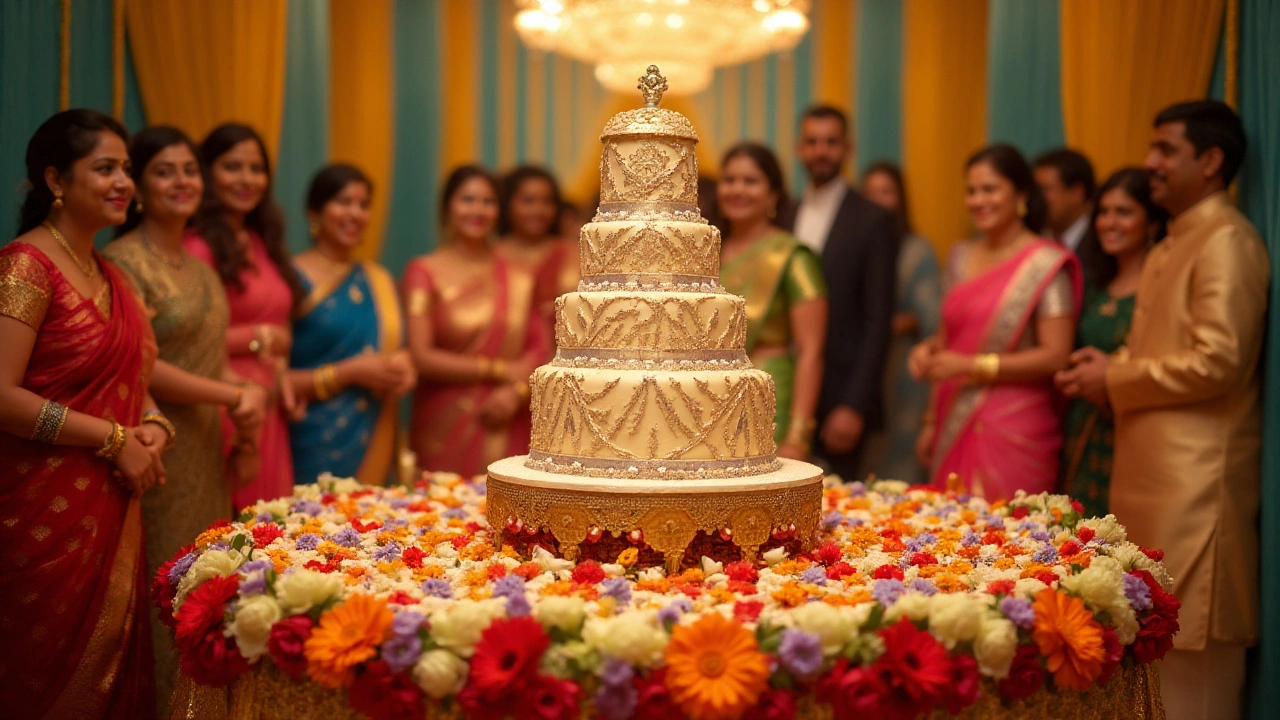
Wedding cakes are not just sweet treats or a grand centerpiece at the reception — they are steeped in tradition and superstition, whispered through the generations and woven into various cultural tapestries. Many couples might not be aware that the act of cutting the cake or saving a piece for later is more than a simple tradition; it carries with it echoes of ancient beliefs and hopes for the future.
Throughout history, these superstitions have evolved, adapted, and flourished. They serve as a bridge between the past and the present, adding layers of meaning to what might initially seem like mere frosting and sponge.
Our journey through wedding cake superstitions unravels these customs, offering an insight into what they mean for newlyweds today. Are they a delicate blend of tradition and charm? Or merely tasty tales from the past? Read on to discover the intriguing world behind the icing.
- Historical Origins of Wedding Cake Superstitions
- Symbolism and Traditions Across Cultures
- Saving a Slice: Good Luck or Myth?
- Cutting the Cake: Symbolic Gestures
- Modern Interpretations of Cake Superstitions
- Tips for Incorporating Traditions Into Modern Weddings
Historical Origins of Wedding Cake Superstitions
The wedding cake has a history as rich and layered as the dessert itself, with roots reaching back to ancient Roman times. In those days, it wasn’t the confectionery masterpiece we associate with modern weddings. Instead, the Romans used a simple barley cake, which was broken over the bride’s head as a symbol of fertility and good fortune. Guests would pick up the crumbs to take some of the luck home with them, a practice that planted the seed for many of today’s wedding traditions.
As time marched forward into medieval England, the custom evolved. It became common practice for guests to bring small cakes and pile them in front of the bride and groom. The challenge was for the couple to kiss over this towering pile. Successfully doing so without toppling it was seen as a promising omen of a prosperous union and numerous children. It is this tradition that eventually morphed into the modern tiered cake we recognize today, with each layer signifying something joyful about marriage, whether it be wealth, health, or happiness.
During the 17th century, the idea of incorporating fruitcakes emerged due to their ability to preserve well thanks to sugar. These fruitcakes took on the mantle of tradition, embodying the sentiment of a marriage destined for longevity and endurance. The sugar, spices, and fruits within these cakes were costly and thus a show of affluence and stature. This choice of cake became so revered that many families considered it bad luck if the cake was not a fruitcake.
Interestingly, this tradition crossed the ocean to colonial America where it merged with local customs. It is fascinating how certain rituals managed to travel along with immigrants, evolving as they intermingled with local culture. In some parts of early America, the groom’s cake gained popularity. These cakes were often dense, sometimes made of dark chocolate, and were meant to celebrate the groom and his preferences.
“In wedding traditions, the cake often symbolizes the sweet promise for the future and the couple’s shared joy,” says renowned historian Dr. Elizabeth Dowling. Her studies reveal how confections have been used in rites of passage across different cultures.
As societies became more affluent, lavish decorations became a regular feature of wedding cakes. The Victorians, in particular, took decoration to new heights, with Queen Victoria’s wedding to Prince Albert spurring the widespread popularity of white icing, symbolizing both purity and the wealth to afford refined sugar. This touch of elegance established the foundation for visual and cultural expectations surrounding wedding cakes that persist into the modern era.
The juxtaposition of tradition and innovation in wedding cake superstitions reflects the ever-changing tide of fashion and society. Over centuries, the wedding cake evolved from merely a symbol of fertility and luck to a grand centerpiece that captures the essence and hopes of a relationship. Such transformation demonstrates the limitless potential for creating meaningful symbols from even the simplest beginnings.
Symbolism and Traditions Across Cultures
The wedding cake journey is a tale as old as time, transcending borders and blending cultures. Across the globe, wedding traditions have attached profound meanings to these sugary delights, each layer often bearing a story of its own. In ancient Rome, bread was broken over the bride's head, symbolizing fertility and prosperity. This ritual evolved, traversing through centuries and morphing into beautifully tiered cakes we cherish today.
In France, wedding cakes are known as croquembouche, towering confections of choux pastry, traditionally believed to bring joy and prosperity to the newlyweds. The cake is not just a dessert but a sculptural marvel that encourages guests to reach in and share the good fortune. Meanwhile, in England, the tradition of the fruitcake has not only survived but thrived. Layers of rich, boozy fruitcake are believed to indicate wealth and fertility, echoing the gratitude and abundance couples wish to share as they embark on this lifelong union.
As author Sarah Franklin notes, "The fruitcake stands as a symbolic testament—a slice of heritage at each wedding feast."
Across the Indian subcontinent, towering confections are not as prevalent. However, shared cultural sweets like laddoos and barfis take their pride of place during wedding celebrations, with each bite being a blessing of sweetness and success. In Japan, the wedding cake may not even be a cake! Often, imitation cakes are used for symbolic cake-cutting photos, a testament to intricate ceremonial customs. It's served after the reception, usually with another sweet delight, mirroring the simplicity and understated elegance found in Japanese culture.
Replicating the taste of tradition with modern twists is no easy feat, yet couples frequently choose to honor their heritage through these delectable centerpieces. Incorporating wedding cake superstitions in design and ingredients reflects an appreciation of the past while paving the way for a hopeful future. By offering tiers of towering tales and beliefs, wedding cakes around the world continue to foster diversity, showcasing the universal language of love and unity in its sweetest form.
Indeed, these confections underscore a universal yearning—a hunger for good fortune, fecundity, and shared happiness—proven by their presence in nearly every culture. Whether it’s a slice of Black Forest in Germany symbolizing lush and bountiful marriage, or the ceremonial nut cake in Eastern Europe representing strength and fidelity, the lore of these sugary delights is limitless. It's no wonder these traditions are cherished and shared as couples continue to exchange vows. Such fervor casts a fresh lens on what remains one of the world's universal wedding confections, ensuring that the stories, the magic, and, of course, the cakes, are celebrated now and for generations to come.
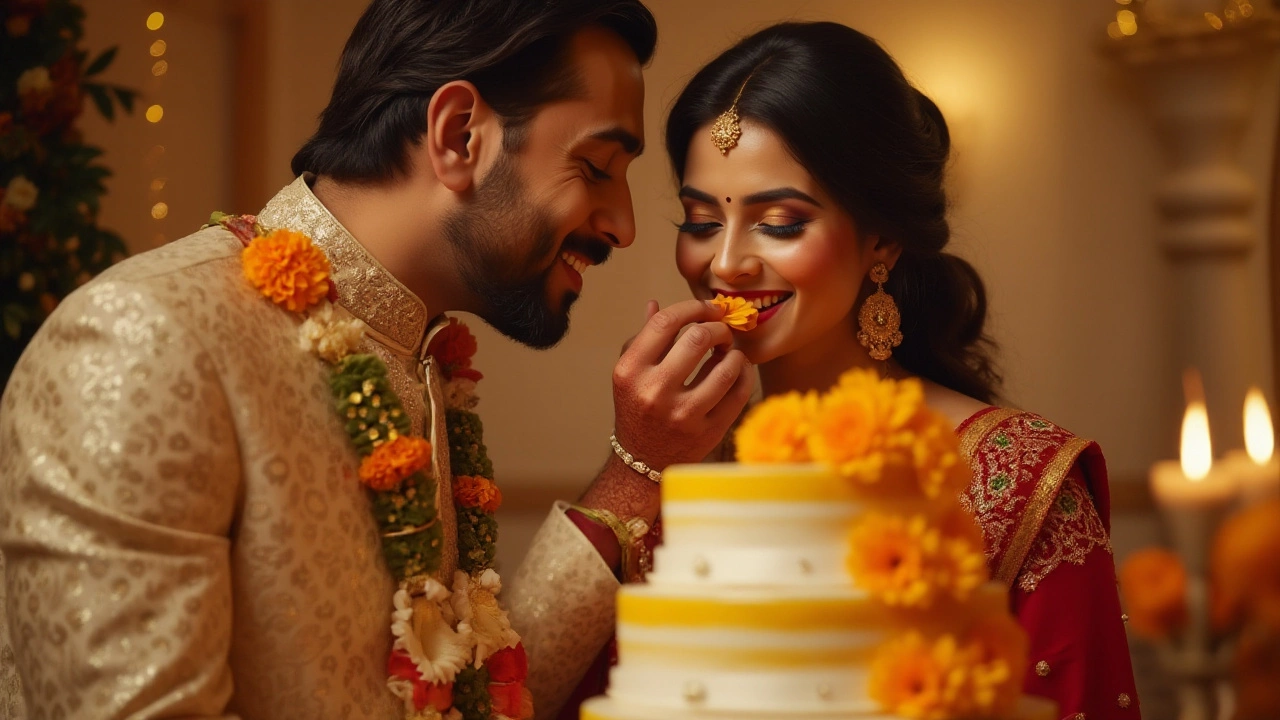
Saving a Slice: Good Luck or Myth?
The tradition of saving a slice of wedding cake holds nostalgia for some while swirling with superstitions for others. Rooted in Victorian times, this practice originally involved preserving the top tier of the cake for the couple’s first anniversary, or the christening of the first child, which was thought to symbolize prosperity and continuity. Wrapped lovingly in foil, cocooned in a tin, it became a talisman of good fortune, echoing wishes of a lasting union and fruitful future.
In contrast, skeptics argue it’s nothing more than a charming relic of the past, met with modern cynicism and a race against culinary freshness. The idea was that shared celebration of the saved slice would reinforce the bond between newlyweds, sealing happiness in sugar and flour. Yet, not everyone buys into these beliefs, as practicality often triumphs over superstition in contemporary times.
Curiously, this custom travels through different cultural veins. In some cultures, eating the cake slice was considered to predict the gender of the first child, whereas in others, it was believed to protect the couple from infertility or marital discord. Some families even pass down their saved cake slice through generations as an heirloom, further entwining bonds over centuries.
“Sharing the joy of the wedding cake's slice a year later brings back a morsel of the magic from the special day,” says Elizabeth Jameson, a noted expert on cultural wedding traditions.
Although few follow strict preservation rules rigorously, many couples have embraced the essence of the tradition with modern tweaks. Some opt for a fresh cake on their anniversary, featuring elements reminiscent of their wedding cake, as a homage to the sweet superstition. This adaptation captures the spirit of the original practice without the need for freezer space or fear of stale cake.
Of course, the heart of this tradition may lie in its storytelling charm rather than scientific fact, resonating most with those with a penchant for romance and nostalgia. The shared slice becomes a symbol of remembrance, bridging the past and future with every bite. And thus, it remains alive, nestled among the array of wedding cake superstitions that still delight and intrigue couples around the world.
Cutting the Cake: Symbolic Gestures
The cutting of the wedding cake is more than a moment for photo ops; it's an age-old ritual loaded with symbolism that varies across cultures and continues to evolve. Traditionally, this gesture represented the first task the newlyweds undertook together, a joint step into their shared future. As the couple holds the knife together, they are symbolically indicating their partnership in all aspects of life, emphasizing unity and collaborative decision-making. Often, this act is accompanied by cheers and applause from guests, marking it as a pivotal moment in the wedding ceremony.
Historically, the groom's role in the cake cutting was to demonstrate his ability to protect and provide for his bride. It was common in Victorian times for the bride to cut the first slice, signifying the end of virginity. Today, the act of cutting the cake has transformed into a more egalitarian gesture, embodying notions of partnership and equality. The first slice is traditionally shared between the couple, symbolizing their commitment to care and provide for each other throughout their life together.
Interestingly, some families incorporate their own wedding traditions with the cake. For instance, some cultures believe breaking pieces of cake over the bride's head brings good luck and prosperous marriage. The crumbs supposedly carry blessings and ensuring abundance. In modern American weddings, these customs are more playful in nature, with couples delicately feeding each other. This stand as a public display of love and tenderness, showcasing both intimacy and camaraderie with their guests.
“A wedding cake is like a marriage; each component plays a part. It's the icing on the union that brings it all together.” - Unknown
While the cutting of the cake marks an important social signal, it’s fascinating how this simple act has taken on a life of its own. With its blend of ritual and festivity, it resonates with layers of cultural significance. In contemporary Muslim weddings, for example, the significance is tied to community. The cake cutting is less an act of partnership and more of an indication of shared joy with the community, representing a new union within a wider family.
Whether whispered behind lace or shared in joyous laughter with friends and family, the cutting of the wedding cake remains a centerpiece ritual. By embracing both new and old wedding cake superstitions, couples add personalized touches to their celebration, crafting moments that speak to their unique journey. A union, after all, is as much about embracing the old as it is about making space for the new.
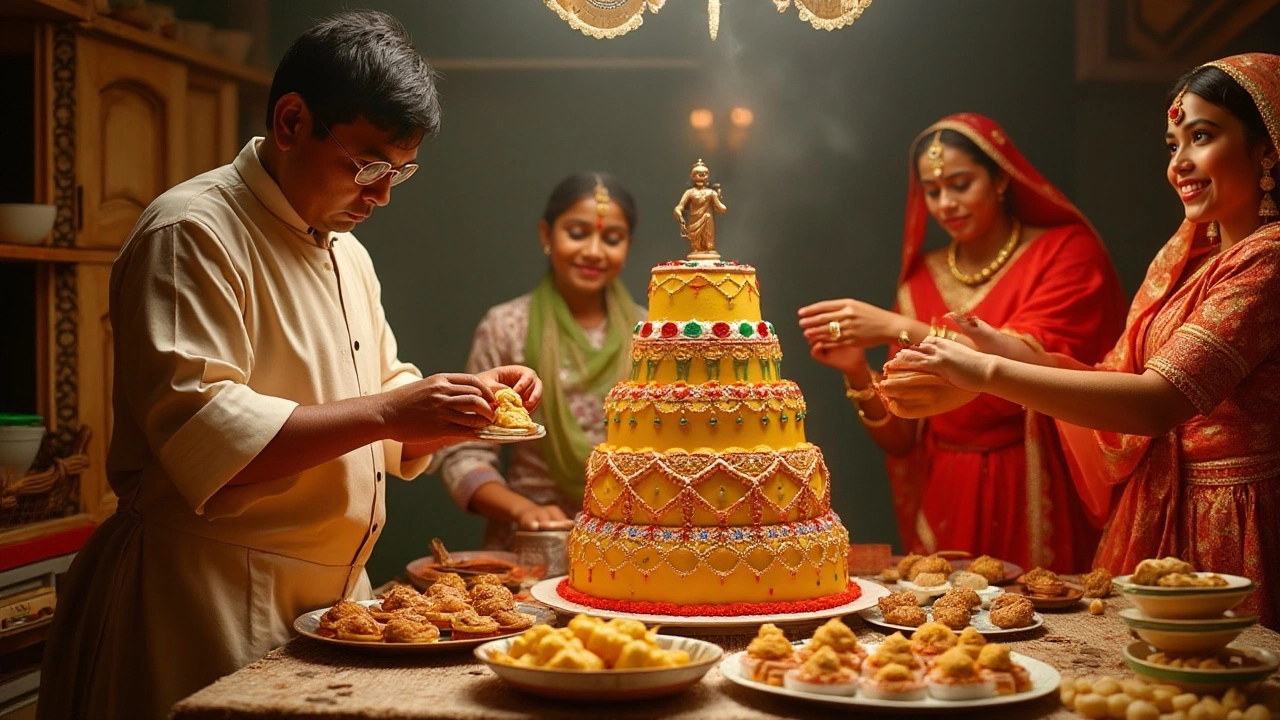
Modern Interpretations of Cake Superstitions
As couples wander the path toward matrimony, the role of the wedding cake continues to sparkle with modern interpretations, each one carrying echoes of yesteryear while stepping boldly into today's world. In this age of Instagram and Pinterest, the wedding cake has taken on new life, serving not only as a symbol of union but also as an expression of personal style and creativity. The superstitions surrounding these towering confections have evolved too, merging tradition with the contemporary in fascinating ways.
One popular modern take on cake superstitions is the idea of saving the top tier. While the anciant custom involved preserving it for the couple's first anniversary, today it often becomes the centerpiece for a couple’s first child’s baptism or another significant life event. This shift reflects the flexible nature of traditions, which can adapt to fit the rhythm of personal milestones. The act of freezing a slice is often infused with hope and anticipation for the future, akin to saving a beautiful memory that’s rekindled a year later, with the taste of nostalgia and celebration.
Today’s wedding traditions might also incorporate a blend of cultural superstitions, especially in multicultural ceremonies. For example, in some Asian cultures, incorporating certain flavors or ingredients believed to bring luck or prosperity can be seen as an extension of those traditional beliefs. Cakes with red frosting or decorations, symbolic of happiness and joy, are becoming increasingly prevalent in Western weddings influenced by Asian themes.
Creativity thrives when couples are reimagining cake designs with nods to age-old beliefs. Some opt to create elaborate sugar flowers symbolizing fertility and love, echoing down through history, while others integrate personalized cake toppers that hold special significance, like figurines representing family heritage or passions shared by the couple. Blending these superstitions with personal narratives, modern weddings often showcase cakes that are both a feast for the taste buds and a rich tapestry of symbols that celebrate the couple’s journey.
Modern interpretations also include an increasing trend of mini cakes or cupcakes as a nod to the traditional belief of sharing good luck with guests. Thoughtfully arranged in whimsical tiers, these smaller treats invite everyone to partake in the joyous occasion, turning the cake into a communal blessing that aligns with both new and ancient traditions.
"A cake at a wedding is a taste not just of sweetness but of history. Holding numerous cultural beliefs, it continues to be a symbol of life's pleasures and unpredictability." - Emily Post Institute
The way we perceive these cake beliefs today is as varied as the flavors on offer, and yet they continue to weave a continuity between the past and the present. Whether it’s the preservation of the top tier or whispered wishes embedded in the cake's design, these wedding cake superstitions have found new breaths of life. While styles and servings may have evolved, the cake remains a delicious liaison to tradition, providing a taste of both the old world and the couple's bright future.
Tips for Incorporating Traditions Into Modern Weddings
Embracing traditions within the vibrant tapestry of modern weddings can add a touch of nostalgia and charm, enhancing the depth of the ceremony through meaningful acts. It is fascinating to observe how couples today blend these age-old customs within their unique and personal wedding narratives. Integrating superstitions or customs, like those associated with the wedding cake, offers a timeless connection to cultural roots. Even if today’s newlyweds are trendsetting individuals with innovative visions, including a piece of tradition often provides a warm link to heritage and familial continuity.
One of the simplest ways to incorporate tradition is by choosing a wedding cake design that nods to ancestral themes or regional flavors. Many couples select cakes flavored with fruits and spices that carry symbolic meanings or are known to be favorites from family recipes, thus forging a bond with lineage. Some even opt for layers or decorations reflecting motifs from cultural stories or patterns respected through years. A popular tradition, widely observed and adapted, is saving the top tier of the wedding cake. Originally believed to bring luck and fertility, saving the cake for a first anniversary or a christening subtly weaves in this belief, creating an heirloom of sorts in taste and experience.
Incorporating these customs doesn't mean you have to compromise on your contemporary style. It can be a delightful melding. Consider, for instance, the act of cake-cutting, which represents the first sweet task undertaken jointly by the couple. Transform this traditional moment by having family members share stories or blessings while the cake is being cut. It becomes an intimate memory, cherished and captured amidst the celebration. Complement this with a modern flourish like a unique cake topper symbolizing shared dreams or future aspirations.
While tradition offers a backdrop of sentimentality, infusing it into a modern setting can sometimes present challenges. A thoughtful balance, more often than not, lies in personalization. Couples should consider customizing these traditions to reflect their relationship's journey, aspirations, and personal meanings. This could involve inviting family elders to share their cake-related stories, whether humorous mishaps or touching reflections. Interactive cake design stations, where each guest designs a piece meaningfully inscribed with wishes, also bridge generations in a beautiful way.
Incorporating traditions isn't exclusive to the wedding cake alone. Other customs, such as wearing something old, that can link directly to the cake itself. For instance, using a cake knife passed down through generations, inscribed with dates and names, blends tradition with today’s celebratory spirit. This sensitivity to detail transforms what could be a simple moment into an extraordinary one filled with memory and meaning.
"Incorporating traditions tailors the ceremony, ensuring guests and partnered hearts alike connect to the celebration’s essence," notes renowned wedding planner Anna Gordon.
Finally, understanding that traditions vary widely in interpretation and significance across cultures is vital for those looking to incorporate them thoughtfully. Couples might find it rewarding to delve deeper into understanding why a particular superstition exists and explore creative ways to adapt it. From selecting traditional flavors to including ancient rites, a modern wedding entwined with past customs becomes a celebration for everyone present, resonating with shared histories and future hopes alike. The art of balancing both worlds invites couples to create a heartfelt ceremony reverberating with joyful potential.
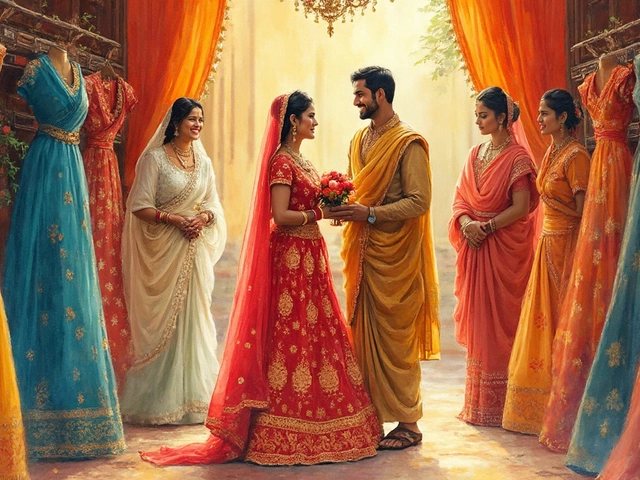
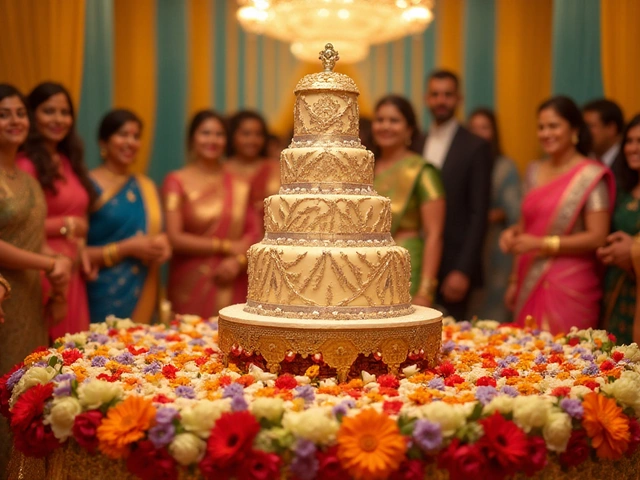

Comments
Post Comment